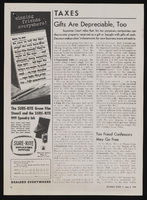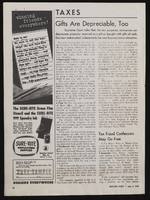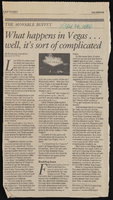Search the Special Collections and Archives Portal
Search Results

Gregory Koehler oral history interview: transcript
Date
Archival Collection
Description
Oral history interview with Gregory Koehler conducted by Claytee D. White on May 15, 2019 for the Remembering 1 October Oral History Project. Koehler begins talking about his family, early life, and occupation. He explains the line of jobs he has had, his history with firefighting, and how he moved to Las Vegas, Nevada in 2003. Koehler then recalls how he had attended the Route 91 Festival concert and the events that unfolded during the shooting. He describes what he saw, felt, and how he tried to help the people who were shot. Lastly, he talks about the aftermath of the event and the struggles he had gone through.
Text
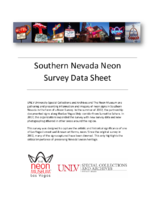
The Beat Coffeehouse Neon Survey document, September 17, 2017
Date
Archival Collection
Description
Site address: 520 Fremont St
Sign owner: Michael and Jennifer Cornthwaite
Sign details: This location opened in 2009, but closed in 2016. It will reopen as Eureka!, which is a chain of restaurants based in California.
Sign condition: 5- was a relatively new sign and shined brightly
Sign form: Hanging sign
Sign-specific description: This sign was skeletal neon making the letters "the beat" in a bubble letter font. The word 'the' lights up blue and 'beat' is red neon.
Sign - type of display: Neon
Sign - media: Steel
Sign environment: This location is in the Fremont East District on Fremont and 6th Street in the Emergency Arts Center.
Sign - date of redesign/move: Currently this sign is not visible from public view
Sign - thematic influences: This sign showcases a good use of skeletal neon.
Sign - artistic significance: The property's decor is representative of the bohemian, indie, hipster trend of the mid 2000s into the the 2010s.
Survey - research locations: Review Journal article https://www.reviewjournal.com/entertainment/food/the-beat-coffeehouse-in-downtown-las-vegas-to-close-later-this-year/ , The Beat website http://www.thebeatlv.com/ , Las Vegas Weekly article https://lasvegasweekly.com/intersection/2016/jul/12/losing-the-beat-coffeehouse-detriment-to-downtown/ , Vegas Eater website https://vegas.eater.com/2016/9/26/13051480/the-beat-coffeehouse-closes
Surveyor: Wyatt Currie-Diamond
Survey - date completed: 2017-09-17
Sign keywords: Neon; Hanging
Text
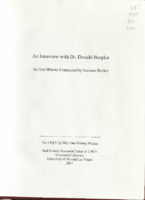
Transcript of interview with Dr. Donald Baepler by Suzanne Becker, April 23, 2007
Date
Archival Collection
Description
Text

Transcript of interview with Neil H. Holmes by Laura Bell, February 12, 1975
Date
Archival Collection
Description
On February 12, 1975, collector Laura Bell interviewed her neighbor, plant mechanic foreman, Neil H. Holmes (born on November 16th, 1897 in Chicopee, Kansas) in the collector’s home in Boulder City, Nevada. This interview covers the construction of Boulder (Hoover) Dam. During this interview Neil also discusses local living conditions in 1931.
Text

Jack K. Leavitt interview, February 28, 1979: transcript
Date
Archival Collection
Description
On February 28, 1979, collector Alick Dziabczenko interviewed Jack Leavitt in Las Vegas, Nevada. In this interview Mr. Leavitt talks about his childhood in Las Vegas. He also talks about his family life and his career in the city, as well as some of the many changes he has seen in Las Vegas.
Text

Interview with Linda (Mack) Smith, October 6, 2006
Date
Archival Collection
Description
Text

